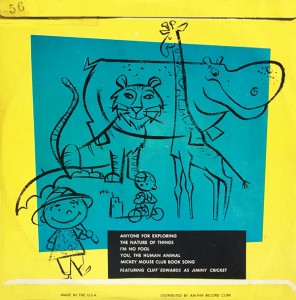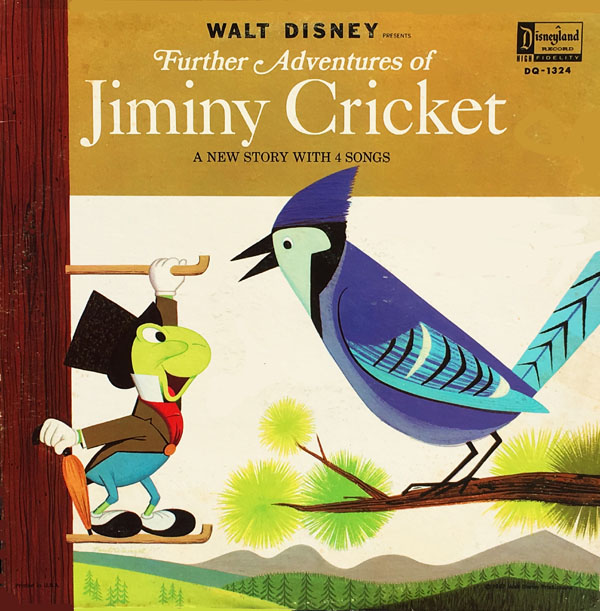A look at two records by one of the most popular stars of Broadway, Hollywood and the early record industry, in the signature cartoon role he first voiced in Pinocchio.

Walt Disney’s
JIMINY CRICKET SINGS
5 Mickey Mouse Club Songs
Featuring Cliff Edwards as Jiminy Cricket
with Jimmie Dodd, The Mouseketeers, Chorus and Orchestra
Official Mickey Mouse Club Records (Am-Par) DBR-56 (10” 78 RPM / Mono / 1955) \
Producer: Jimmy Johnson. Musical Director: Buddy Baker. Choral Direction: Arthur Norman. Running Time: 9 minutes.
Songs: “Anyone for Exploring?” “The Nature of Things,” “I’m No Fool,” “You Are a Human Animal,” “Mickey Mouse Club Book Song,” by Jimmie Dodd.
 Jiminy Cricket is the consummate animated feature sidekick. All subsequent sidekicks owe him their careers. He is also the first feature character to be a recurring presence on TV (with the exception of Tinker Bell, who flew and zapped on the Disneyland TV series). His strength is in breaking the fourth wall throughout Pinocchio and, in almost every instance, continuing to do so.
Jiminy Cricket is the consummate animated feature sidekick. All subsequent sidekicks owe him their careers. He is also the first feature character to be a recurring presence on TV (with the exception of Tinker Bell, who flew and zapped on the Disneyland TV series). His strength is in breaking the fourth wall throughout Pinocchio and, in almost every instance, continuing to do so.
The Jiminy in the 1940 classic had a jaunty attitude, used slang of the day and had an eye for the ladies. These characteristics were lessened (and the last one eliminated) when he became a spokesman for common sense and education. What never went away was his down to earth way of communicating.
Jiminy is a household name among cartoon characters, but he’s not often recognized for what he brought to TV. It was one thing for Jimmie Dodd, Buffalo Bob, Captain Kangaroo or even Bozo to gently guide kids through issues of safety and good citizenship; it was another for an animated character to be so believable in the same role. Jiminy could be trusted. He gave us very good advice even if, like Pinocchio, we very seldom followed it.
There were several Jiminy segments on the Mickey Mouse Club and the songs on this extended play 78 and 45 RPM record were the theme songs (a 45 RPM record was also released in 1975 with a slightly different playlist).
The most famous is probably “I’m No Fool.” Even when the Mickey Mouse Club and Pinocchio were out of release in the ’60s and ’70s, schools rented the films. As kids, these were the ones we were happiest to see (in addition to cool Bell Science live-action/animated films). Few Disney characters were as accessible during this time.
This is one of the early Official Mickey Mouse Club records. This one was distributed by “Am-Par” records, which was a division of ABC. Others were released on Golden Records. They all sold so well that Roy Disney was finally convinced to start an in-house label to keep the profits at home. It was the beginning of a new dawn in baby boomer children’s records.
Our knowledgeable pal Jim Korkis shared a history of Cliff Edwards here – and the “I’m No Fool” films here.
GIVE A LITTLE LISTEN
“The Nature of Things”
Obviously, this theme started films about animals and nature. Others were about health, safety, learning and exploration. It makes one wonder if later teaching albums by characters like Popeye and Yogi Bear were inspired by the films and even the records.

Walt Disney Presents
THE FURTHER ADVENTURES OF JIMINY CRICKET
Disneyland Records DQ-1324 (12” 33 1/3 RPM / Mono / 1967)
Executive Producer: Jimmy Johnson. Producer: Camarata. Writer: Tom Campbell. Running Time: 21 minutes.
Performers: Cliff Edwards (Jiminy Cricket); Robie Lester (Alwon, Blue Fairy); Carol Lombard, Ron Hicklin (Singers).
Songs: “Just What You Ought to Be,” “I Can Finally Fly” by Tom Campbell, Steve Gillette; “When You Wish Upon a Star” by Ned Washington, Leigh Harline; “Buckeye Jim (Traditional).
 As Tim Hollis and I reported in Mouse Tracks: The Story of Walt Disney Records, Cliff Edwards was plagued by bitter divorces, tax problems and physical issues. He was troubled even in his Pinocchio days, which came after a superstar-level career in which he was known as “Ukelele Ike,” with hit songs, films and appearances. He was even the first to perform “Singin’ in the Rain” on screen in The Hollywood Revue of 1929, in which Laurel and Hardy and a very young Jack Benny also appeared.
As Tim Hollis and I reported in Mouse Tracks: The Story of Walt Disney Records, Cliff Edwards was plagued by bitter divorces, tax problems and physical issues. He was troubled even in his Pinocchio days, which came after a superstar-level career in which he was known as “Ukelele Ike,” with hit songs, films and appearances. He was even the first to perform “Singin’ in the Rain” on screen in The Hollywood Revue of 1929, in which Laurel and Hardy and a very young Jack Benny also appeared.
Edwards’ Disney friends—and Jiminy’s popularity—were a life saver for the performer until his passing in 1971. According to Jimmy Johnson’s memoir, Cliff Edwards was not looking well when he came to the studio to make his last records. This may have been one of them. From 1967, the Edwards heard here isn’t the same peppy guy heard in the record above, and even less like the chipper chirper in Pinocchio.
 The late Eddie Carroll, who had masterfully voiced the post-Cliff Edwards Jiminy for decades, recalled his audition, in which he was given a Jiminy recording as a guide, but it was not very helpful because of Edwards’ obviously weakened condition. Perhaps this was the recording.
The late Eddie Carroll, who had masterfully voiced the post-Cliff Edwards Jiminy for decades, recalled his audition, in which he was given a Jiminy recording as a guide, but it was not very helpful because of Edwards’ obviously weakened condition. Perhaps this was the recording.
The album itself is pleasant, but doesn’t really pay off its title. These are neither further adventures, nor do they really have to do with Jiminy himself. Discuss.
Instead there is just one adventure, in which Jiminy is a narrative bystander, about a tree who wishes to be a bird. The Blue Fairy grants the wish and excitement, danger and learned lessons ensue. Along the way, there are two original songs sung in Peter, Paul and Mary fashion. This singing style was also used for songs on 1966’s A Happy Birthday with Winnie the Pooh. It was a very different sound for Disney records, but not without its success; the Pooh record was nominated for a Grammy and the song “Birthday, Birthday” was reissued on several subsequent records.
In the liner notes, writer Tom Campbell takes part in a fictional account of how he came to write the story and co-wrote the songs—a very unusual touch. Campbell also co-wrote the songs for the Pooh album mentioned above.
GIVE A LITTLE LISTEN
Excerpt from “The Further Adventures of Jiminy Cricket”
Here’s an bit of the narration and a portion of one of Campbell’s songs. Even at this stage of Cliff Edwards’ life, there is still a reassuring warmth in his voice.


 GREG EHRBAR is a freelance writer/producer for television, advertising, books, theme parks and stage. Greg has worked on content for such studios as Disney, Warner and Universal, with some of Hollywood’s biggest stars. His numerous books include Mouse Tracks: The Story of Walt Disney Records (with Tim Hollis). Visit
GREG EHRBAR is a freelance writer/producer for television, advertising, books, theme parks and stage. Greg has worked on content for such studios as Disney, Warner and Universal, with some of Hollywood’s biggest stars. His numerous books include Mouse Tracks: The Story of Walt Disney Records (with Tim Hollis). Visit 





















































Around this same time, he must have recorded the albums “Addition and Subtraction” and “Multiplication and Division.” Despite Jiminy’s prominence on the covers, his participation in the albums is somewhat marginal. He doesn’t seem entirely “up” to the vocals he does achieve. By the last half of “M and D” he is not heard at all.
What a difference from the inflections and welcoming tones of a few years previously.
“The Further Adventures” was an album I wanted as a child, but never got. Now hearing it, I think I might have felt disappointed in listening to it. Cliff Edwards on this one is just not the Jiminy Cricket of yore.
“The Nature of Things,” by contrast, is the Jiminy Cricket we all remember–a cheerful, optimistic voice full of a zest for life. He also did a fairly decent job with another long-playing album “A Day at Disneyland” in which his narration is “added” to a pre-existing recording of Walt Disney. In his heyday and for a long time afterward, Cliff Edwards was certainly the definitive voice of Jiminy Cricket. He still is today.
Thanks for sharing!
That same year, Jiminy had a new voice for that year’s broadcast of “From All of Us to All of You” (when he introduced the “surprise gift” of a Jungle Book sneak preview).
Anyone know who the jacket illustrators are?
Greg,
Curious to see if you can help me solve a mystery. I have a 4-CD compilation from Reader’s Digest Music titled A STRING OF PEARLS: GREAT STARS OF THE ’40S. On this compilation is a performance of “When You Wish Upon a Star” by Cliff Edwards that I don’t recognize. The credit line reads “Cliff Edwards with Orchestra and Chorus Directed by Sonny Burke.” Do you know anything of the origin of this recording? It appears to be a mono recording, and Edwards is still very much in his prime. Just curious because I’d never run across this one before.
Thanks
Cliff Edwards recorded that particular version of “When You Wish Upon a Star” for the Decca label on March 8, 1955. On the same day he also recorded “Give a Little Whistle,” “Jiminy Cricket” and “The Bird and the Cricket and the Willow Tree.” All four songs were released on a 7-inch EP titled SONGS FROM DISNEYLAND, as well as on 78 rpm and 45 rpm singles.
Thanks Randy! That’s what I wanted to know.
I actually have this album autographed by Berny Wolf. I knew his daughter. I don’t know how she and I ever got on the subject of Jiminy Cricket, but she said, “my dad drew him for Disney”. So she took the album I have and took it home to her dad to autograph for me.
Bernard “Berny” Wolf
In 1935 Wolf, Eugster, and Culhane, moved to Walt Disney Studios. After working briefly in the Shorts Department, Wolf moved on to features. He was one of the animators of Jiminy Cricket in Pinocchio, and the Centaurs in Fantasia. His final work at Disney was on Dumbo (1941).
Does anyone have an idea of what it might be worth?
Thanks.